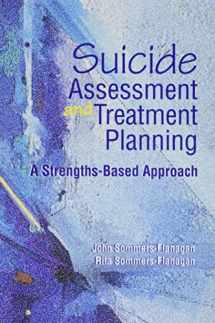
Suicide Assessment and Treatment Planning: A Strengths-Based Approach
Book details
Summary
Description
"Writing a book about suicide may not have been our best idea ever. Rita made the point more than once that reading and writing about suicide at the depth necessary to write a helpful book can affect one''s mood in a downward direction. She was right, of course. Her rightness inspired us to pay attention to the other side of the coin, so we decided to integrate positive psychology and the happiness literature into this book. As is often the case when grappling with matters of humanity, focusing on suicide led us to a deeper understanding of suicide''s complementary dialectic-a meaningful and fully-lived life--and that has been a very good thing. Before diving into these pages, please consider the following. Do the Self-Care Thing In the first chapter, we strongly emphasize how important it is to practice self-care when working with clients who are suicidal. Immersing ourselves in the suicide literature required a balancing focus on positive psychology and wellness. While you''re reading this book and exploring suicide, you cannot help but be emotionally impacted, and we cannot overstate the importance of you taking care of yourself throughout this process and into the future. You are the instrument through which you provide care for others . . . and so we highly encourage you to repeatedly do the self-care thing. What is the Strengths-Based Approach? Many people have asked, "What on earth do you mean by a strengths-based approach to suicide assessment and treatment planning?" In response, we usually meander in and out of various bullet points, relational dynamics, assessment procedures, and try to emphasize that the approach is more than just strength-based, it''s also wellness-oriented and holistic. By strength-based, we mean that we recognize and nurture the existing and potential strengths of our clients. By wellness-oriented we mean that we believe in incorporating wellness activities into counseling and life. By holistic we mean that we focus on emotional, cognitive, interpersonal, physical, cultural-spiritual, behavioral, and contextual dimensions of living. You will find the following strengths-based, wellness-oriented, and holistic principles woven into every chapter of this book. 1.Historically, suicide ideation has been socially constructed as sinful, illegal, or a terribly frightening and bad illness. In contrast, we believe suicide ideation is a normal variation on human experience that typically stems from difficult environmental circumstances and excruciating emotional pain. Rather than fear client disclosures of suicidality, we welcome these disclosures because they offer an opportunity to connect deeply with distressed clients and provide therapeutic support. 2. Although we believe risk factors, warning signs, protective factors, and suicide assessment instruments are important, we value relationship connections with clients over predictive formulae and technical procedures. 3. We believe trust, empathy, collaboration, and rapport will improve the reliability, validity, and utility of data gathered during assessments. Consequently, we embrace the principles of therapeutic assessment. 4. We believe that counseling practitioners need to ask directly about and explore suicide ideation using a normalizing frame or other sophisticated and empathic interviewing strategies. 5. We believe traditional approaches to suicide assessment and treatment are excessively oriented toward psychopathology. To compensate for this pathology-orientation, we explicitly value and ask about clients'' positive experiences, personal strengths, and coping strategies. 6. We believe the narrow pursuit of psychopathology causes clinicians to neglect a more complete assessment and case formulation of the whole person. To compensate, we use a holistic, seven-dimensional model to create a broader understanding of what''s hurting and what''s helping in each individual client''s life. 7. We value the positive emphasis of safety planning and coping skills development over the negative components of no-suicide contracts and efforts to eliminate suicidal thoughts. The Book''s Organizing Themes This book includes 10 chapters are organized to build on one another and in ways that are consistent with our understanding of the research literature in suicide theory, research, and practice. We begin the seven dimensions with the emotional dimension, because, as Edwin Shneidman wrote, psychological or emotional distress is the primary driving force at the heart of suicide. In our model, all risk factors and life dimensions contribute in some way or another to deep and excruciating emotional distress and deep and excruciating emotional distress pushes people toward suicide"--


We would LOVE it if you could help us and other readers by reviewing the book
Book review



